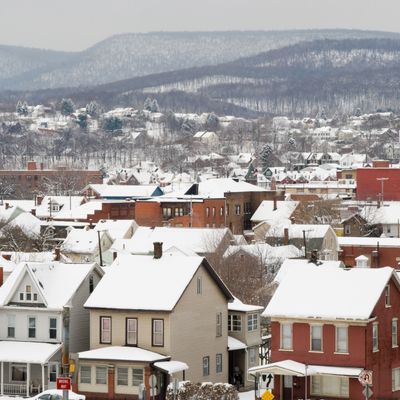
One of the more remarkable developments of this election cycle has been the sudden identification of the party of Ronald Reagan — you know, the sunny, optimistic patron saint of conservatism who thought of America’s future as being as bright as its sacred past — with the dystopian stylings of Donald Trump. The simplest explanation has been that Trump represents a powerful backlash in the white working-class Republican “base” against economic policies — championed by GOP elites — that don’t work for them, especially “free trade” agreements, laws encouraging and forgiving large-scale immigration, and “entitlement reforms” that affect white middle-class benefits.
Because so many of the white, working-class grievances Trump has exploited have involved not just elites but people of color (from domestic “welfare bums” to immigrant Latinos to demonic Chinese), he’s wound up in a competition to see if he can rev up the white vote in order to offset the negative energy he’s generated among nonwhite voters. And that competition has highlighted the long-term problem Republicans face in dealing with demographic changes in the U.S. population.
Unsurprisingly, Trump’s approach to economics and culture has helped him do better than recent Republican presidential candidates in states with a lot of white, working-class voters but relatively few minority residents (e.g., Iowa, Ohio, and Wisconsin), while making it tougher for him in states with a lot of minority voters and a relatively well-educated white population (e.g., Florida and North Carolina). Ron Brownstein explains how that has upset our traditional understanding of the battleground states and how they lean:
The demographic and geographic trends reverberating through 2016 could produce a electoral alignment unlike any since the passage of the 1964 Civil Rights Act shattered the Democratic hold on the “solid South.”
This reconfiguration largely leaves the same states at the center of the electoral deck, but shuffles which party looks to which state for a win. It’s a shift symbolized by Clinton’s clear decision to focus more effort on Florida and even North Carolina than on Ohio, the state traditionally considering the tipping point in presidential elections. (Clinton finally returned to Ohio Monday after nearly a month-long absence.)
The shift Brownstein’s talking about isn’t just of interest to media buyers or others with a direct stake in where the two major parties look for national victories. Because Republicans are now the ascending party in what we think of as the sclerotic industrial-age Rust Belt, while Democrats seem fated to build a majority in the vibrant and increasingly diverse Sun Belt, the mood switch represented by the saturnine Trump and the upbeat Clinton may become a regular part of the political landscape.
That could create cognitive dissonance in large swaths of the chattering classes. A whole generation of conservative writers (Michael Barone, for example, has dwelled on this theme obsessively for at least 20 years) have come to think of the Sun Belt as the fountainhead of cultural and economic vitality, places where booming exurbs are teeming with married couples raising families in jobs supplied by beneficent, union-free capitalists attracted by low taxes and minimal regulations. These lucky Real Americans own their own homes, regularly attend church, love the military, and distrust every other element of government. That’s changing. To be sure, Republicans are expected to continue to dominate south-central Sun Belt states like Alabama, Mississippi, Tennessee, Louisiana, and Oklahoma for the foreseeable future. But the Sun Belt states we think of as most vibrant are another matter: Virtually everyone expects Arizona and Georgia to join Florida, North Carolina, and Virginia as blue-trending states quite soon, with Texas close behind.
At the same time, many liberal analysts watching the recent progress of Republicans in the Rust Belt have warned that conservatives are trying to transplant the values and policies of the Sun Belt far from their native habitat. It’s certainly alarming to Democrats to see Michigan and Wisconsin enacting “right-to-work” laws and electing and reelecting Republican governors and legislative majorities. What could be happening, however, is a gradual role reversal in which those ancient bastions of stolid labor-oriented social democracy north of the Mason-Dixon line join the more stagnant southern precincts in a coalition of unhappy white people whose pasts outweigh their futures.
This possibility should haunt Republicans who think that once Donald Trump is out of the way they can go back to the project of expanding from a secure southern Sun Belt base into diverse and growing areas elsewhere, eventually including places like California once the monkey of suspected anti-Latino prejudice is off their backs. Trump may just be the leading edge of a trend that was happening anyway. And progressive Democrats who believe the white working class will return to them if their leaders stop “betraying” these people, and who tend to regard the South as the source of everything evil (you know, religion and guns and fried foods), may need to take a fresh look at the map as well. The trends we see in this abnormal political year may represent a new normal after all.






























